[English] 日本語
 Yorodumi
Yorodumi- PDB-6ofe: Helical reconstruction of Type III Secretion System Needle filame... -
+ Open data
Open data
- Basic information
Basic information
| Entry | Database: PDB / ID: 6ofe | |||||||||||||||||||||||||||||||||
|---|---|---|---|---|---|---|---|---|---|---|---|---|---|---|---|---|---|---|---|---|---|---|---|---|---|---|---|---|---|---|---|---|---|---|
| Title | Helical reconstruction of Type III Secretion System Needle filament mutant-PrgI S49A | |||||||||||||||||||||||||||||||||
 Components Components | Protein PrgI | |||||||||||||||||||||||||||||||||
 Keywords Keywords | PROTEIN TRANSPORT / Type III secretion / helical reconstruction / PrgI filament / salmonella | |||||||||||||||||||||||||||||||||
| Function / homology |  Function and homology information Function and homology informationtype III protein secretion system complex / protein secretion by the type III secretion system / cell surface / extracellular region / identical protein binding Similarity search - Function | |||||||||||||||||||||||||||||||||
| Biological species |  Salmonella typhimurium (bacteria) Salmonella typhimurium (bacteria) | |||||||||||||||||||||||||||||||||
| Method | ELECTRON MICROSCOPY / helical reconstruction / cryo EM / Resolution: 3.61 Å | |||||||||||||||||||||||||||||||||
 Authors Authors | Guo, E.Z. / Galan, J.E. | |||||||||||||||||||||||||||||||||
| Funding support |  United States, 1items United States, 1items
| |||||||||||||||||||||||||||||||||
 Citation Citation |  Journal: PLoS Biol / Year: 2019 Journal: PLoS Biol / Year: 2019Title: A polymorphic helix of a Salmonella needle protein relays signals defining distinct steps in type III secretion. Authors: Emily Z Guo / Daniel C Desrosiers / Jan Zalesak / James Tolchard / Mélanie Berbon / Birgit Habenstein / Thomas Marlovits / Antoine Loquet / Jorge E Galán /     Abstract: Type III protein-secretion machines are essential for the interactions of many pathogenic or symbiotic bacterial species with their respective eukaryotic hosts. The core component of these machines ...Type III protein-secretion machines are essential for the interactions of many pathogenic or symbiotic bacterial species with their respective eukaryotic hosts. The core component of these machines is the injectisome, a multiprotein complex that mediates the selection of substrates, their passage through the bacterial envelope, and ultimately their delivery into eukaryotic target cells. The injectisome is composed of a large cytoplasmic complex or sorting platform, a multiring base embedded in the bacterial envelope, and a needle-like filament that protrudes several nanometers from the bacterial surface and is capped at its distal end by the tip complex. A characteristic feature of these machines is that their activity is stimulated by contact with target host cells. The sensing of target cells, thought to be mediated by the distal tip of the needle filament, generates an activating signal that must be transduced to the secretion machine by the needle filament. Here, through a multidisciplinary approach, including solid-state NMR (SSNMR) and cryo electron microscopy (cryo-EM) analyses, we have identified critical residues of the needle filament protein of a Salmonella Typhimurium type III secretion system that are involved in the regulation of the activity of the secretion machine. We found that mutations in the needle filament protein result in various specific phenotypes associated with different steps in the type III secretion process. More specifically, these studies reveal an important role for a polymorphic helix of the needle filament protein and the residues that line the lumen of its central channel in the control of type III secretion. | |||||||||||||||||||||||||||||||||
| History |
|
- Structure visualization
Structure visualization
| Movie |
 Movie viewer Movie viewer |
|---|---|
| Structure viewer | Molecule:  Molmil Molmil Jmol/JSmol Jmol/JSmol |
- Downloads & links
Downloads & links
- Download
Download
| PDBx/mmCIF format |  6ofe.cif.gz 6ofe.cif.gz | 262.1 KB | Display |  PDBx/mmCIF format PDBx/mmCIF format |
|---|---|---|---|---|
| PDB format |  pdb6ofe.ent.gz pdb6ofe.ent.gz | 218.7 KB | Display |  PDB format PDB format |
| PDBx/mmJSON format |  6ofe.json.gz 6ofe.json.gz | Tree view |  PDBx/mmJSON format PDBx/mmJSON format | |
| Others |  Other downloads Other downloads |
-Validation report
| Summary document |  6ofe_validation.pdf.gz 6ofe_validation.pdf.gz | 816.7 KB | Display |  wwPDB validaton report wwPDB validaton report |
|---|---|---|---|---|
| Full document |  6ofe_full_validation.pdf.gz 6ofe_full_validation.pdf.gz | 819.9 KB | Display | |
| Data in XML |  6ofe_validation.xml.gz 6ofe_validation.xml.gz | 32.7 KB | Display | |
| Data in CIF |  6ofe_validation.cif.gz 6ofe_validation.cif.gz | 54.1 KB | Display | |
| Arichive directory |  https://data.pdbj.org/pub/pdb/validation_reports/of/6ofe https://data.pdbj.org/pub/pdb/validation_reports/of/6ofe ftp://data.pdbj.org/pub/pdb/validation_reports/of/6ofe ftp://data.pdbj.org/pub/pdb/validation_reports/of/6ofe | HTTPS FTP |
-Related structure data
| Related structure data |  20043MC  6offC  6ofgC  6ofhC M: map data used to model this data C: citing same article ( |
|---|---|
| Similar structure data |
- Links
Links
- Assembly
Assembly
| Deposited unit | 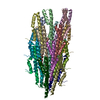
|
|---|---|
| 1 |
|
| Symmetry | Helical symmetry: (Circular symmetry: 1 / Dyad axis: no / N subunits divisor: 1 / Num. of operations: 20 / Rise per n subunits: 4.19 Å / Rotation per n subunits: 63.35 °) |
- Components
Components
| #1: Protein | Mass: 9131.145 Da / Num. of mol.: 20 / Mutation: S49A Source method: isolated from a genetically manipulated source Source: (gene. exp.)  Salmonella typhimurium (strain SL1344) (bacteria) Salmonella typhimurium (strain SL1344) (bacteria)Strain: SL1344 / Gene: prgI, SL1344_2853 / Production host:  Has protein modification | N | |
|---|
-Experimental details
-Experiment
| Experiment | Method: ELECTRON MICROSCOPY |
|---|---|
| EM experiment | Aggregation state: FILAMENT / 3D reconstruction method: helical reconstruction |
- Sample preparation
Sample preparation
| Component | Name: PrgI S49A / Type: COMPLEX / Details: single mutant of PrgI / Entity ID: all / Source: RECOMBINANT |
|---|---|
| Source (natural) | Organism:  Salmonella typhimurium (strain SL1344) (bacteria) Salmonella typhimurium (strain SL1344) (bacteria) |
| Source (recombinant) | Organism:  |
| Buffer solution | pH: 7.5 |
| Specimen | Embedding applied: NO / Shadowing applied: NO / Staining applied: NO / Vitrification applied: YES |
| Specimen support | Details: unspecified |
| Vitrification | Cryogen name: ETHANE |
- Electron microscopy imaging
Electron microscopy imaging
| Experimental equipment |  Model: Titan Krios / Image courtesy: FEI Company |
|---|---|
| Microscopy | Model: FEI TITAN KRIOS |
| Electron gun | Electron source:  FIELD EMISSION GUN / Accelerating voltage: 300 kV / Illumination mode: FLOOD BEAM FIELD EMISSION GUN / Accelerating voltage: 300 kV / Illumination mode: FLOOD BEAM |
| Electron lens | Mode: BRIGHT FIELD |
| Image recording | Electron dose: 47.2 e/Å2 / Film or detector model: GATAN K2 SUMMIT (4k x 4k) |
- Processing
Processing
| Software | Name: PHENIX / Version: 1.12_2829: / Classification: refinement | ||||||||||||||||||||||||
|---|---|---|---|---|---|---|---|---|---|---|---|---|---|---|---|---|---|---|---|---|---|---|---|---|---|
| EM software | Name: PHENIX / Category: model refinement | ||||||||||||||||||||||||
| CTF correction | Type: PHASE FLIPPING AND AMPLITUDE CORRECTION | ||||||||||||||||||||||||
| Helical symmerty | Angular rotation/subunit: 63.35 ° / Axial rise/subunit: 4.19 Å / Axial symmetry: C1 | ||||||||||||||||||||||||
| 3D reconstruction | Resolution: 3.61 Å / Resolution method: FSC 0.143 CUT-OFF / Num. of particles: 14070 / Symmetry type: HELICAL | ||||||||||||||||||||||||
| Refine LS restraints |
|
 Movie
Movie Controller
Controller





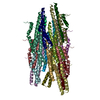
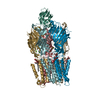
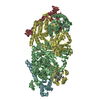
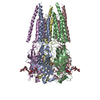
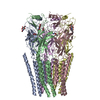
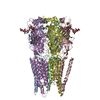
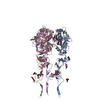
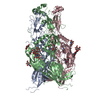
 PDBj
PDBj